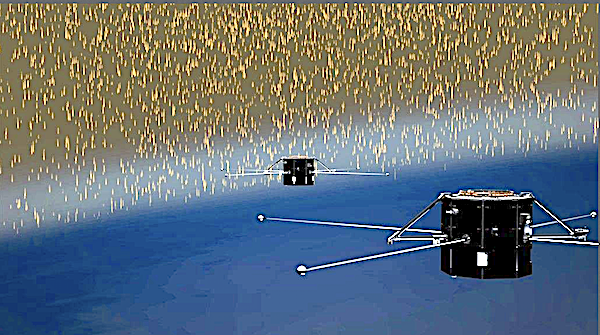
SpaceX is targeting Wednesday, July 23 for Falcon 9’s launch of NASA’s TRACERS mission from Space Launch Complex 4 East (SLC-4E) at Vandenberg Space Force Base in California. The 57-minute launch window opens at 11:13 a.m. PT.
Also on board this mission is SEOPS’ Epic Athena, Skykraft’s Skykraft 4, Maverick Space Systems’ REAL, Tyvak’s LIDE, and York Space Systems’ Bard.
A live webcast of this mission will begin about 15 minutes prior to liftoff, which you can watch on X @SpaceX. You can also watch the webcast on the new X TV app.
This is the 16th flight for the first stage booster supporting this mission, which previously launched Crew-7, CRS-29, PACE, Transporter-10, EarthCARE, NROL-186, Transporter-13, and eight Starlink missions. Following stage separation, the first stage will land on Landing Zone 4 (LZ-4) at Vandenberg Space Force Base.
There is the possibility that residents of and visitors to Santa Barbara, San Luis Obispo, and Ventura counties may hear one or more sonic booms during the launch, but what residents experience will depend on weather and other conditions.
SpaceX plans Tuesday for NASA’s TRACERS to launch from California to understand Earth’s magnetic re-connection + more

SpaceX’s Falcon 9 will launch Tuesday, July 22, at 11:05 AM – 12:44 PM PDT from Vandenberg, California to reach Heliophysics Orbit, Sun-Synchronous Orbit.
NASA’s Tandem Reconnection and Cusp Electrodynamics Reconnaissance Satellites (TRACERS) mission, consisting of two identical satellites that will orbit Earth in tandem (one following the other), will help understand magnetic re-connection and its effects in Earth’s atmosphere. Magnetic re-connection occurs when activity from the Sun interacts with Earth’s magnetic field. By understanding this process, scientists will be able to better understand and prepare for impacts of solar activity on Earth.
The Falcon 9 booster will attempt to return to the launch site at LZ-4 after its flight.
NEWS from NASA
NASA’s TRACERS (Tandem Reconnection and Cusp Electrodynamics Reconnaissance Satellites) spacecraft are targeting launch aboard a SpaceX Falcon 9 rocket during a launch window that opens at 2:13 p.m. EDT (11:13 a.m. PDT) on Tuesday, July 22. The TRACERS mission and three NASA small satellites will launch from Space Launch Complex 4 East at Vandenberg Space Force Base in California.
The TRACERS mission will study how the solar wind, the continuous stream of ionized particles escaping the Sun and pouring out into space, interacts with Earth’s magnetosphere, the region around Earth dominated by our planet’s magnetic field. Understanding this region and space weather patterns is paramount in our increasingly technologically driven society, as space weather events can affect our power grids and communications satellites, and create potentially hazardous conditions for astronauts.
Also launching on this flight are three additional NASA-funded payloads. The Athena EPIC (Economical Payload Integration Cost) SmallSat, led by NASA’s Langley Research Center in Hampton, Virginia, is designed to demonstrate an innovative, configurable way to put remote-sensing instruments into orbit faster and more affordably. The Polylingual Experimental Terminal (PExT) technology demonstration, managed by the agency’s SCaN (Space Communications and Navigation) Program, will showcase new technology that empowers missions to roam between communications networks in space, like cell phones roam between providers on Earth.
Finally, the Relativistic Electron Atmospheric Loss (REAL) CubeSat, led by Dartmouth College in Hanover, New Hampshire, will use space as a laboratory to understand how high-energy particles within the bands of radiation that surround Earth are naturally scattered into the atmosphere, aiding the development of methods for removing these damaging particles to better protect satellites and the critical ground systems they support. The REAL mission is the first CubeSat to launch for the state of New Hampshire as part of NASA’s CubeSat Launch Initiative, which provides low-cost access to space for U.S. educational institutions, informal educational institutions such as museums and science centers, non-profits with educational and outreach components, as well as NASA centers for early career workforce development. With REAL, 39 U.S. states, the District of Columbia, and Puerto Rico will have launched as part of the initiative.
The TRACERS mission is led and managed by David Miles at the University of Iowa with support from the Southwest Research Institute in San Antonio, Texas. NASA’s Heliophysics Explorers Program Office at the agency’s Goddard Space Flight Center in Greenbelt, Maryland, manages the mission for the agency’s Heliophysics Division at NASA Headquarters in Washington. The University of Iowa, Southwest Research Institute, University of California, Los Angeles, and the University of California, Berkeley, all lead instruments on TRACERS that study changes in the magnetic field and electric field. NASA’s Launch Services Program, based at the agency’s Kennedy Space Center in Florida, manages the agency’s VADR (Venture-class Acquisition of Dedicated and Rideshare) contract.
SpaceX to launch NASA’s TRACERS to understand Earth’s magnetic re-connection on Tuesday from California

SpaceX’s Falcon 9 will launch Tuesday, July 22, at 11:05 AM – 12:44 PM PDT from Vandenberg, California to reach Heliophysics Orbit, Sun-Synchronous Orbit.
NASA’s Tandem Reconnection and Cusp Electrodynamics Reconnaissance Satellites (TRACERS) mission, consisting of two identical satellites that will orbit Earth in tandem (one following the other), will help understand magnetic re-connection and its effects in Earth’s atmosphere. Magnetic re-connection occurs when activity from the Sun interacts with Earth’s magnetic field. By understanding this process, scientists will be able to better understand and prepare for impacts of solar activity on Earth.
The Falcon 9 booster will attempt to return to the launch site at LZ-4 after its flight.
